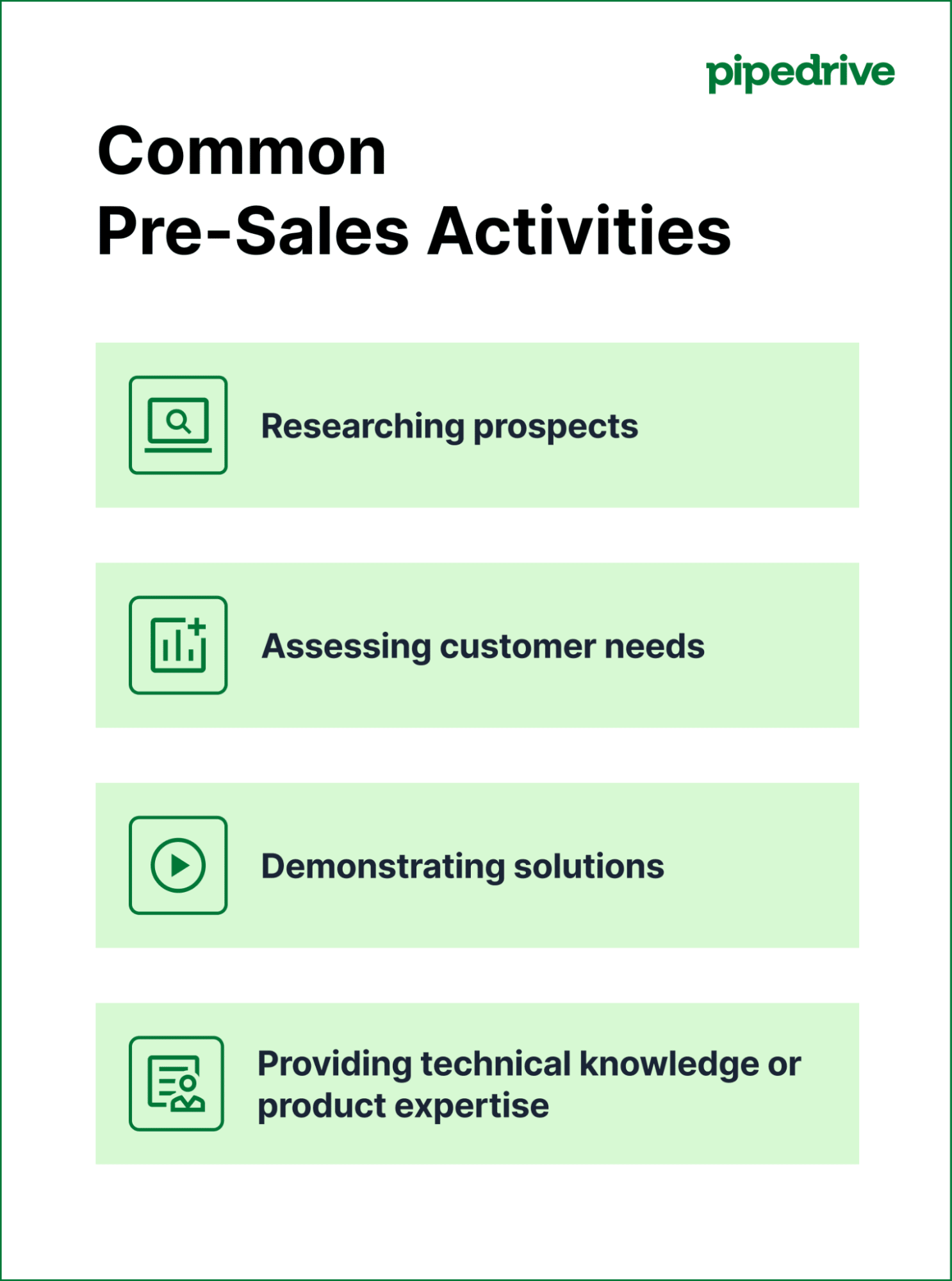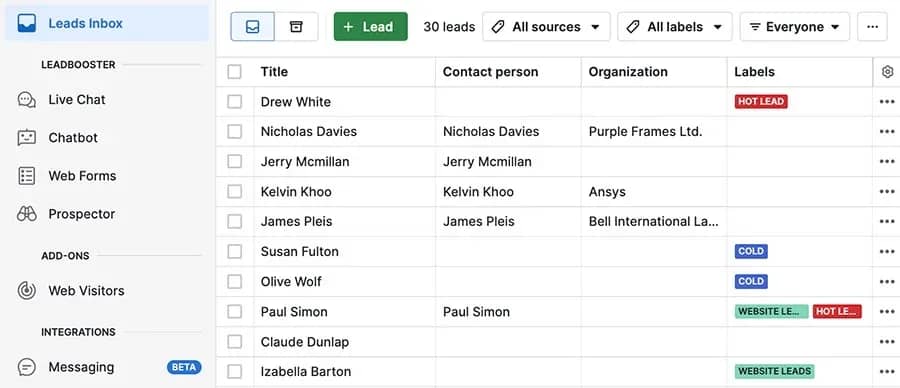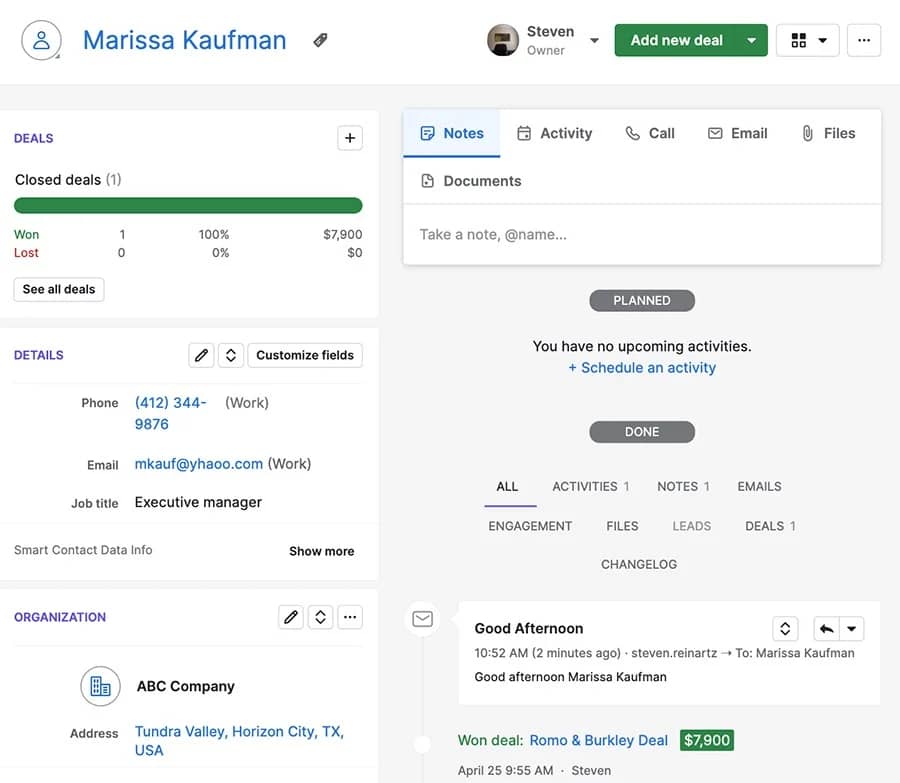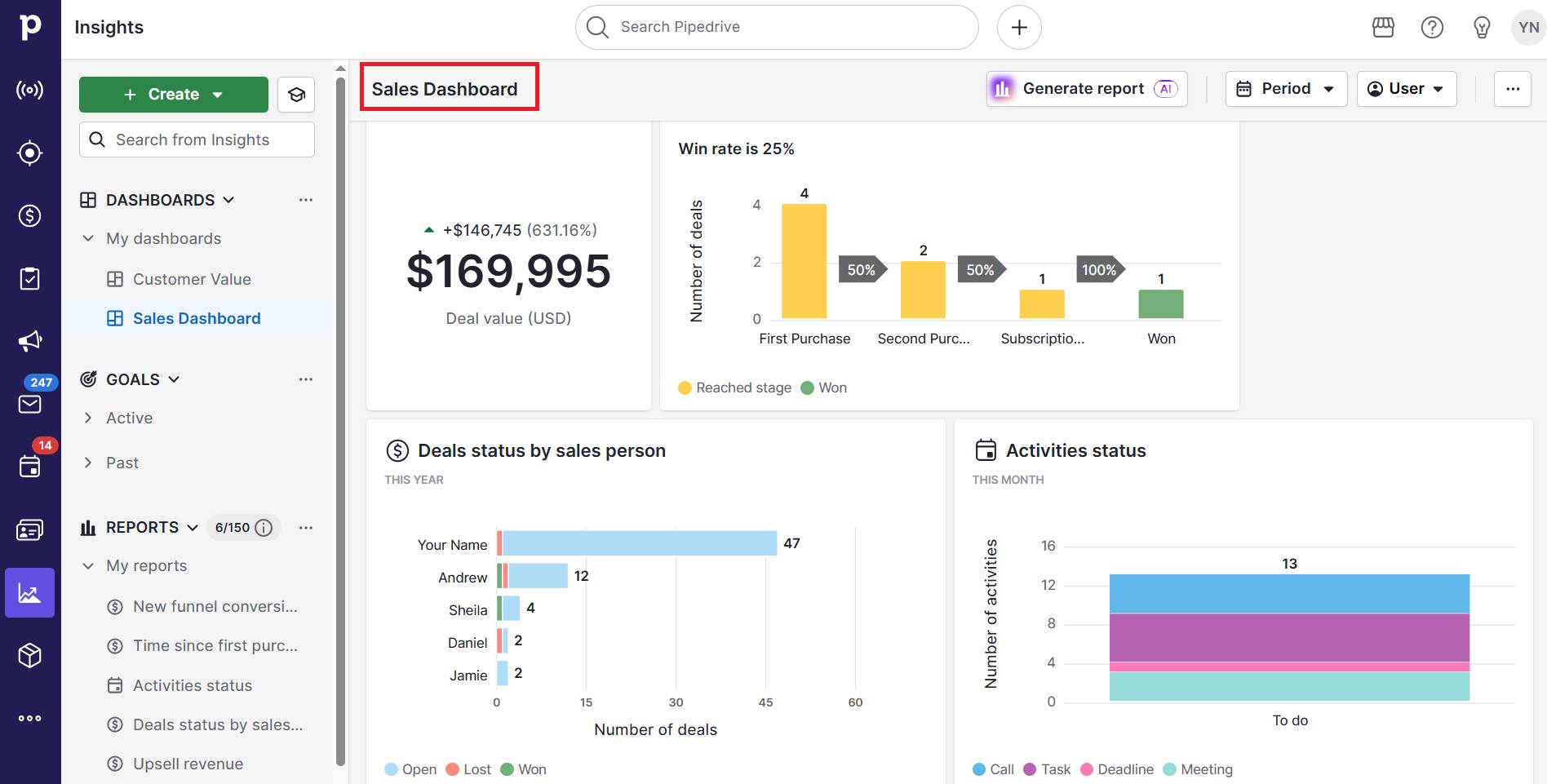Pre-sales activities help SMBs focus on high-potential leads, demonstrate value effectively and close deals faster.
Yet many SMBs struggle with limited time and resources, meaning it’s easy to waste efforts on unqualified prospects.
By prioritizing pre-sales activities, SMBs maximize their time and resources, ensuring every targeted interaction is impactful.
In this article, you’ll learn each step of the pre-sales process, from lead qualification to stakeholder engagement. Then, apply actionable strategies to streamline your approach, improve conversion rates and increase sales.
Key takeaways from what is pre-sales
Pre-sales activities happen in the lead up to a sale, including lead qualification, needs assessment and stakeholder engagement.
These pre-sales steps help SMBs focus on high-potential leads, demonstrate value effectively and close deals faster.
Many SMBs struggle with limited time and resources, but a structured pre-sales process ensures teams prioritize qualified prospects and tailor solutions efficiently.
Pipedrive’s CRM centralizes pre-sales data, tracks performance and helps SMBs prioritize the right deals – sign up for a 14-day free trial to close deals more efficiently.
Pre-sales definition: Pre-sales consists of the activities, processes and interactions that happen before a business closes a deal, typically between the first contact with a lead and the point where they’re ready to buy.
Pre-sales bridges marketing and sales by preparing prospects for a successful purchase. The entire process qualifies leads, educates and engages them and prepares proposals that align with their needs.
By handling key activities early, pre-sales shortens the sales cycle and time to conversion.
Common pre-sales activities include the following:

Take a look at the purpose of each of these activities in more detail:
Function: Gathering information about potential customers to understand their industry, business challenges and buying behavior. What it achieves: This research helps develop a clear understanding of the prospect’s world and tailor outreach accordingly. | |
Assessing customer needs | Function: Engaging with prospects to uncover their goals, pain points and priorities. What it achieves: These insights guide how you position your solution to solve specific challenges and improve customer satisfaction. |
Demonstrating solutions | Function: Showing potential clients how your business solves their challenges. What it achieves: These activities bridge the gap between interest and confidence, allowing prospects to see value firsthand. |
Providing technical knowledge or product expertise | Function: Answering complex product questions, configuring solutions or developing proposals that fit each customer’s technical and business needs. What it achieves: This guidance builds trust and credibility and reassures prospects that your solution meets their requirements. |
Is creating a pre-sales process worth it for smaller businesses?
Pre-sales helps small and medium-sized businesses (SMBs) with limited time and staff to identify which leads are worth pursuing. By qualifying sales prospects early, teams avoid wasting resources on unfit opportunities.
These pre-sales activities speed up the sales cycle since prospects already understand how your product meets their needs before entering formal negotiations.
As a result, you can focus discussions on pricing, implementation and closing rather than continuously clarifying the product’s value proposition.
Effective pre-sales can also improve conversion rates. By building trust and addressing objections upfront, sales teams move from interest to commitment with greater confidence and less friction.
What does the pre-sales process include?
Pre-sales covers all activities that prepare a prospect for a successful sale, turning raw inquiries into qualified, decision-ready opportunities.
To show how pre-sales works in practice, consider the following hypothetical example.
DataCloud, a SaaS company that sells a cloud-based data analytics platform for mid-sized logistics firms, engages with TransLogix, a prospect that manages fleet operations. TransLogix wants better visibility into delivery times and fuel efficiency.
Here are the pre-sales activities that DataCloud might use to guide TransLogix toward a confident purchase decision.
Lead qualification to identify high-potential prospects
Lead qualification helps sales teams focus their time and effort on prospects with high conversion potential, improving efficiency and win rates.
Here’s an example of how lead qualification works as part of pre-sales:
Businesses review inbound leads from product demo requests or sign-ups and outbound prospects from targeted outreach
The company evaluates each lead against its ideal customer profile using criteria such as business size, industry and buying urgency
Teams often apply frameworks like BANT (Budget, Authority, Need, Timeline) to qualify leads quickly and consistently
What this pre-sales activity would look like for DataCloud: DataCloud’s sales development rep (SDR) receives a demo request from TransLogix.
During a short sales discovery call, they confirm that TransLogix operates 200 delivery vehicles, currently relies on spreadsheets for route data and has a budget for analytics software this quarter. The decision-maker is the Head of Operations.
Based on this insight, the sales rep marks TransLogix as a qualified lead and highlights it for deeper assessment.
Start generating quality leads with your B2B Prospecting ebook
Needs assessment to uncover operational challenges
A thorough needs assessment helps salespeople connect product features to a prospect’s pain points, increasing the likelihood of a tailored, high-value proposal at the pre-sales stage.
Here’s how it works:
Businesses schedule discovery calls to learn how prospects operate and where they struggle
Pre-sales teams ask targeted questions about workflows, data sources, reporting methods and business goals
These teams collect detailed insights that reveal inefficiencies and guide how to position the solution
The needs assessment stage helps teams align product value with measurable outcomes.
What this pre-sales activity would look like for DataCloud: During the discovery call, TransLogix explains that it lacks real-time visibility into delivery delays and fuel usage. It manually compiles data from GPS trackers and spreadsheets, taking 10 hours a week.
The primary goal is to reduce delivery delays by 15% and cut fuel costs by 10% over six months.
Solution design to align your product with prospect goals
Custom solution design allows teams to translate prospect needs into practical, tailored offerings that demonstrate real business impact.
Here’s a breakdown of how this customization might look in pre-sales:
Businesses design solutions that match the prospect’s needs identified during discovery
Pre-sales engineers configure features, map data integrations and outline how the solution fits into the customer’s current setup.
The engineers collaborate with technical teams to ensure the design is feasible and minimizes disruption
The goal is to create a clear plan that connects the product’s capabilities to the prospect’s measurable goals.
What this pre-sales activity would look like for DataCloud: DataCloud’s pre-sales engineer proposes integrating directly with TransLogix’s GPS tracking and fuel management systems. The tailored solution will display route performance dashboards and automated efficiency reports.
A two-week configuration plan outlines milestones for setup, testing and training.
Product demonstrations to build confidence and trust
Product demos show prospects how your solution directly improves their operations, helping sales teams turn interest into buying intent.
Delivering product demos typically includes the following steps:
Businesses create tailored sales demos that mirror the prospect’s workflows
Instead of showing generic product functions, pre-sales teams demonstrate product knowledge about specific outcomes (like how the product reduces manual work or enables faster reporting)
Using relevant or sample data helps prospects visualize how the solution performs in their environment and builds confidence in its value.
What this pre-sales activity would look like for DataCloud: DataCloud runs a live demo using sample delivery data from TransLogix. The dashboard highlights late deliveries, identifies routes with excess fuel consumption and suggests optimization strategies.
The pre-sales rep walks through how the system would save roughly 30 staff hours per month.
Proposal and pricing preparation to communicate clear ROI
A well-structured business proposal translates technical value into business outcomes, helping sales teams justify cost and speed up decision-making.
These steps show how sales teams might create proposals to demonstrate ROI:
Businesses prepare detailed proposals that outline the product scope, pricing structure, implementation plan and expected outcomes
Sales reps include subscription options, onboarding details and projected ROI to demonstrate value
A clear, structured proposal helps decision-makers understand costs, benefits and timelines before moving to contract discussions.
What this pre-sales activity would look like for DataCloud: DataCloud’s software proposal for TransLogix includes a quote for 50 user licenses, integration setup and sales onboarding support.
The proposal includes an ROI projection showing potential annual savings of $60,000 from reduced fuel costs and improved scheduling efficiency.
Download your guide to perfecting your sales proposals
Technical or consultative support to remove barriers before sign-off
Technical support addresses final integration or security concerns, ensuring the prospect feels confident committing to the purchase.
Here are some of the ways support teams might ensure a smooth implementation:
Businesses provide technical expertise to confirm how the solution will integrate smoothly with the customer’s systems
Sales engineers review application programming interface (API) compatibility, data security and scalability
Engineers may also run a pilot program or proof of concept (POC) to test real-world performance.
This step builds customer trust and eliminates last-minute obstacles before final approval.
What this pre-sales activity would look like for DataCloud: Before committing, TransLogix’s IT manager asks about data security and integration reliability. DataCloud’s pre-sales engineer provides an architecture diagram, confirms compliance with ISO 27001 standards and sets up a 30-day proof of concept using limited data.
The pilot shows accurate reporting and seamless integration with TransLogix’s GPS.
Stakeholder engagement to secure company-wide buy-in
Engaging all stakeholders early in the pre-sales process ensures alignment across departments, speeding up approvals and reducing deal friction.
Here’s how businesses might engage with all stakeholders:
Businesses identify every stakeholder involved in the buying decision and tailor sales communication to each role
Sales teams hold separate sessions with operations, IT and finance leaders to address their unique concerns and success metrics
Sales reps manage follow-ups to confirm alignment before final sign-off
Effective stakeholder engagement shortens approval cycles and increases confidence in the decision.
What this pre-sales activity would look like for DataCloud: DataCloud’s team presents to TransLogix’s operations director (who focuses on delivery speed), IT lead (who verifies system compatibility) and CFO (who reviews ROI projections).
By addressing each stakeholder’s priorities early and establishing its trustworthiness, DataCloud shortens the final approval process.
How to ensure an effective pre-sales process: 5 tips for SMBs
An effective pre-sales process helps SMBs qualify the right leads, tailor their approach and close deals faster.
Each activity strengthens the link between marketing and sales, ensuring SMBs handle every opportunity efficiently and precisely.
Here’s how to create a pre-sales framework that delivers measurable results.
1. Clearly define lead qualification criteria
Lead qualification sets the standards that determine whether a lead is worth your team’s time, ensuring effort goes toward prospects most likely to convert.
For example, a financial advisory firm might define a qualified lead as a business with:
Over 50 employees
A goal of expanding operations within the next quarter
A budget exceeding $100,000
By defining lead qualification criteria, the sales team can focus on warm leads and increase the likelihood of making a sale.
Clarifying these criteria also standardizes the qualification process. All team members can evaluate leads consistently and prioritize efforts that generate revenue.
Here’s how to define what a qualified lead looks like so your team targets only high-potential prospects:
Identify ideal customer traits. Analyze existing successful clients to define company size, industry, role and budget ranges. Your team can then focus on prospects with similar characteristics.
Apply a qualification framework. Use BANT or similar methods to assess each prospective customer systematically and reduce wasted effort on unfit leads.
Score and prioritize leads. Assign points for key criteria, such as decision-maker involvement and urgency. Scoring leads directs your team to follow up with the most promising opportunities first.
Review and adjust regularly. Update qualification criteria based on market trends, product updates or changes in your ideal customer persona. Regular review keeps your pipeline efficient and aligned with current business goals.
By implementing these steps, your team can focus on the best leads, improving efficiency and effectiveness.
Customer relationship management (CRM) can help you prioritize leads by automatically applying your qualification criteria and ranking prospects, so your team knows exactly which opportunities to focus on first.
Pipedrive’s solution, for example, automatically scores leads based on custom fields such as company size, budget or engagement activity.

This automation ensures your team spends time on the right prospects.
Pipedrive in action: Flowbird, a marketing and CRM implementation company, used Pipedrive’s lead scoring to prioritize prospects based on engagement and activity. This approach helped the sales team focus on the most promising leads, increasing business by 23%.
2. Understand your prospect’s needs
A needs assessment uncovers the customer’s pain points, goals and success metrics before proposing a solution.
Understanding these aspects allows your team to position your product or service as the ideal solution, increasing the likelihood of conversion.
For example, an inventory management company might discover that its prospects are struggling with managing high volumes of seasonal orders. The company offers advanced features and predictive demand forecasting to address these challenges.
By aligning the solution with the prospect’s goals, the sales team builds credibility and proves business value.
Here are some of the ways to gather customer insights and position your solution as an ideal choice:
Research thoroughly. Examine the prospect’s website, press releases and industry trends to understand their business context. Market research gives your team the background needed for informed discussions.
Ask targeted questions. Conduct discovery calls and ask about workflows, business bottlenecks and current tools. Asking the right questions identifies challenges your solution can address.
Document insights systematically. Record all findings in a sales CRM to maintain consistency across your team. Proper documentation prevents repetition and miscommunication.
Map solutions to pain points. Align your product capabilities with the identified challenges to demonstrate direct value. Connecting your solution to real problems helps prospects visualize outcomes clearly.
Thoroughly understanding your prospect’s needs helps you address their specific challenges, increasing the likelihood of a successful sale.
Pipedrive’s customer management software supports needs assessment by centralizing all prospect and customer information in one place. Your team can log discovery call notes, track interactions, store research insights and attach relevant documents directly to each lead or deal.
Here’s an example of a contact in Pipedrive, where you can see activity, call, email and file history:

Centralizing communication and documentation ensures that everyone on the sales team can access the same up-to-date information without miscommunication or repeated questions.
3. Customize solutions and demos
Customization ensures demos and sales pitches that reflect the prospect’s real-world use cases, making it easier for customers to see value.
For example, a consulting services firm might customize a demo to show how its solution can streamline project management processes. The demo focuses on how the solution can improve efficiency and reduce costs for potential customers.
Tailoring presentations to the prospect’s needs and challenges demonstrates a deep understanding of their business and positions the consulting firm as the ideal solution.
Here’s how to adapt your presentations to show how you address each prospect’s goals:
Incorporate realistic workflows or data. Show prospects how your solution operates in scenarios similar to their environment to help them understand practical applications.
Emphasize measurable benefits. Focus on results such as time and cost savings or efficiency improvements to reinforce the product’s value. Pipedrive’s custom fields let you track past successes and relevant metrics, making it easy to showcase outcomes that resonate with the prospect.
Summarize actionable takeaways. End presentations with clear next steps and expected impact. Summarizing takeaways ensures prospects leave with a concrete understanding of benefits.
Customizing your solutions and demos lets you highlight the value of your offering, making prospects more likely to buy.
4. Ensure sales reps are confident with pre-sales tasks
A confident salesperson can manage demos, proposals and consultative discussions without errors, maintaining professionalism and momentum.
For example, an IT company might train its sales team to conduct technical demos and create customized proposals to address specific client needs.
Providing the sales team with the necessary training and resources ensures they can effectively nurture leads to close more deals.
Note: While large organizations often have pre-sales teams, SMBs typically do not. Ensure sales reps master pre-sales activities to maintain deal velocity and deliver a professional customer experience without additional resources.
Take a look at some of the ways to provide practical sales team training:
Provide structured training. Offer sessions on discovery, demo delivery and proposal creation to equip reps with proven methods.
Develop sales enablement materials. Create sales playbooks, FAQs, case studies and other materials to minimize mistakes and build confidence. With Pipedrive, reps can access these readily available documents in Smart Docs, which keeps all resources centralized and easily retrievable.
Encourage practice sessions. Run role-play or mock demos to strengthen delivery and objection-handling skills. Practice improves performance during real client interactions.
Gather feedback and improve. Review performance after each engagement to identify areas for improvement. Using Pipedrive’s web forms, collect structured client feedback to help reps refine selling techniques and increase success rates.
Ensuring your sales reps are confident and well-prepared means you can boost deal velocity without additional resources.
5. Track and measure pre-sales performance
Tracking pre-sales metrics shows which activities boost sales and where you need to improve.
A SaaS sales leader might track metrics (such as demo attendance) to assess the effectiveness of their pre-sales efforts.
Monitoring these key performance indicators (KPIs) helps the team identify successful strategies and areas for improvement, creating more efficient sales pipelines that lead to higher conversion rates.
Here are some of the ways to monitor pre-sales performance:
Track key metrics. Measuring lead-to-opportunity conversion, demo attendance and sales proposal success highlights which actions produce results.
Compare performance across reps. Analyze which reps close more deals or achieve faster cycles to replicate effective practices across your team.
Collect prospect feedback. Request the prospect’s input after demos or trials to learn what influenced their buying decisions. Use their feedback to inform improvements to presentations, proposals and demos.
Continuously refine processes. Use insights from metrics and feedback to optimize lead scoring, demo customization and proposal preparation.
Tracking and measuring pre-sales performance consistently helps you make data-driven decisions to enhance your process and improve sales outcomes.
Using a CRM allows you to centralize data, monitor key metrics and identify trends in your pre-sales activities.
For instance, Pipedrive’s in-depth analytics dashboards track conversion rates, demo effectiveness and proposal success:

This overview provides clear visibility into where deals stall and which pre-sales actions drive the most impact.
Pipedrive in action: Spark Interact used Pipedrive’s analytics dashboards to monitor key metrics and identify areas for improvement. With these insights, the digital agency increased revenue by 12% year-over-year without expanding its sales team.
Final thoughts
Pre-sales helps SMBs qualify leads, tailor solutions and close deals faster.
Define lead criteria, understand customer needs and track performance to create consistent high-value opportunities.
A CRM centralizes data and provides visibility into every pre-sales activity. Pipedrive, for example, tracks lead engagement, demo effectiveness and proposal success to prioritize high-potential deals.
Sign up for a 14-day free trial to see which prospects drive revenue and efficiently close deals.






